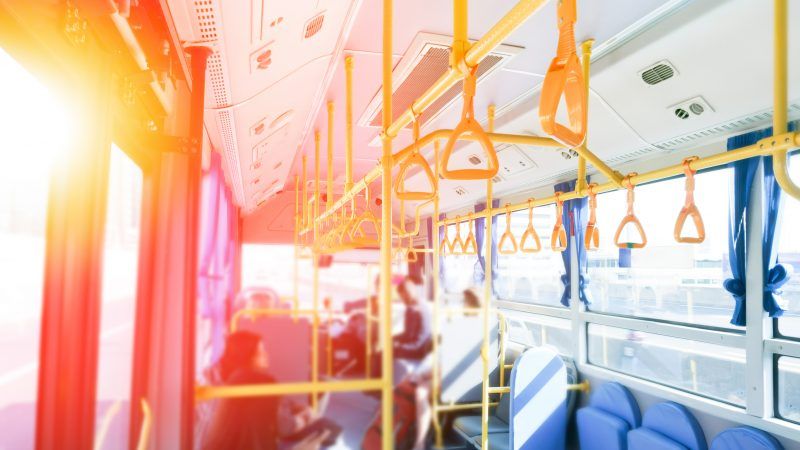Should Public Buses Be Free to Riders?
Kansas City wants everyone except bus riders to pay for bus rides.

From Midwestern city councils to masked anarchists, everyone seems to be embracing the idea of free public transit.
In late November, fare strikes hit transit systems across the country, with activists hopping turnstiles and vandalizing ticket machines to protest the cost of living, police brutality, neoliberalism, etc.
This was followed last Thursday by Kansas City's government voting unanimously for a resolution that directs the city manager to create a plan for eliminating fares on all city buses. The legislators didn't deploy the protesters' radical rhetoric, but they agreed on this much: Free public transit is better both for the environment and for low-income riders.
"Free bus service is more environmentally friendly, and it provides a transformative advantage for low-income residents who need a ride to work or school," wrote the Kansas City Star's editorial board in an article supporting the elimination of fares.
Free transit, of course, isn't actually free.
Kansas City's bus and bus rapid transit services cost about $75 million a year to operate, according to Federal Transit Administration data from 2017. Fare-box revenue made up about $8.5 million of that, or roughly 11 percent of all operating costs.
That's low, but it's not nothing. Additional subsidies would be required to make the system whole.
But for some officials, finding $8 million of other people's money is no big deal. "That's not a ton of money," City Councilman Eric Bunch told a local NBC affiliate after the vote. "If we want to prioritize public transportation, it's something that we can find."
So long as fares continue to bring in some money, it makes sense to keep them, counters Baruch Feigenbaum, a transportation scholar at the Reason Foundation (which publishes this website).
"Whether it's 20 percent of the recovery rate or 40 percent of the recovery rate, it's a lot better than zero percent of the recovery rate," says Feigenbaum. "From a fiscal perspective, you should do it just because you need the funding."
Feigenbaum also argues that transportation—regardless of mode—should follow a "users pay, users benefit" model, where riders pay as close to the full cost of their ride as possible. This gives transit agencies a stronger incentive to provide quality service to riders or else risk losing the revenue that comes with them. Cities concerned about helping low-income riders could just give them transit vouchers, says Feigenbaum, without shifting the cost of everyone's rides onto taxpayers.
The historical experience of transit systems going fare-free is mixed.
It has proven more successful when implemented in smaller resort and college towns, where populations surge on a seasonal basis and where ill-used transit systems have a lot of spare capacity to add new riders.
Larger cities that experimented with fare-free public transit have seen ridership increases, but also overcrowding and significantly reduced on-time rates .
According to one 2012 report, both Denver and Austin saw major increases in ridership when they temporarily abolished fares. Ridership increased 49 percent in Denver and 70 percent in Austin. But as that same report notes, Denver increased service and redesigned its bus routes at the same time that it eliminated fares, possibly explaining much of the increase in ridership. Likewise, Austin's fare-free experiment came right as the city's transit agency extended service to the University of Texas, which also gave students free bus passes.
Both cities eventually abandoned fare-free transit, citing overcrowding, lost revenue, and an increased number of "problem passenger" incidents.
Other large cities' fare elimination strategies have produced more modest ridership gains. When Estonia's capital, Tallinn, made its public transportation service free, it registered only a 3 percent increase in ridership over the following five years.
That's because most riders would rather have a better-functioning bus service than a cheaper one.
According to a 2019 survey of transit riders in seven cities from TransitCenter, a transit advocacy group, most riders—including most low-income riders—said that improved service was a higher priority than lowering or eliminating fares. "If a transit agency had to choose between devoting funds to reducing fares or to maintaining or improving service, most riders would prefer the latter," the organization noted in January.
Kansas City is going in the opposite direction. Time will tell how well that will work.
Rent Free is a weekly newsletter from Christian Britschgi on urbanism and the fight for less regulation, more housing, more property rights, and more freedom in America's cities.

Show Comments (87)